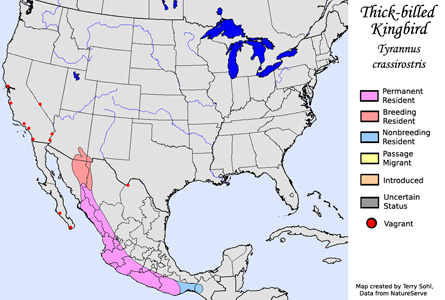Thick-billed Kingbird
Tyrannus crassirostris
| Length: 9.5 inches | Wingspan: 16 inches | Seasonality: Non-resident in South Dakota |
| ID Keys: Dark gray upperparts, white below, large thick bill, pale yellow underparts on juvenile | ||
 The
Thick-billed Kingbird is a large flycatcher species with a range mostly in
Mexico. They were unknown in the United States until the late 1950s,
when they started appearing in southern Arizona and New Mexico. They
have evidently been expanding their summer range to the north, and are now
found regularly in select locations in Arizona and New Mexico.
The
Thick-billed Kingbird is a large flycatcher species with a range mostly in
Mexico. They were unknown in the United States until the late 1950s,
when they started appearing in southern Arizona and New Mexico. They
have evidently been expanding their summer range to the north, and are now
found regularly in select locations in Arizona and New Mexico.
Habitat: In the United States portion of their range, Thick-billed Kingbirds are most often found in forested riparian areas, particularly in areas of cottonwoods and sycamore trees. In the Mexican part of their range, they are found in a variety of open woodlands and woodland edges.
Diet: Feeds on insects and spiders.
Behavior: Forages by observing from a perch and flying out to capture insects in mid-air. They will also occasionally glean insects from vegetation foliage and branches.
Nesting: The nest of a Thick-billed Kingbird is a large cup of sticks, grasses, leaves, weed stems, and leaves. The female usually lays 3 or 4 eggs, and she alone incubates them. When the eggs hatch, both parents help to feed the young.
Song: Song of a Thick-billed Kingbird is a metallic buzzing and clicking.
Migration: Considered a permanent resident in much of their Mexican range, those found in the southwestern United States are just summer breeding residents. Some wandering birds have overwintered in California or parts of the Southwest.
Interactive eBird Map: Click here to access an interactive eBird map of Thick-billed Kingbird sightings
Similar Species: Thick-billed Kingbird has mostly white underparts and a thick bill that distinguish it from other kingbird species found in the same area. Juvenile Thick-billed Kingbirds have a pale yellow belly, and may possibly be confused with the other kingbirds in the region with yellow bellies (Cassin's Kingbird, Tropical Kingbird).
Conservation Status: Populations are found over a relatively wide geographic area and appear to be increasing. The IUCN lists the Thick-billed Kingbird as a species of "Least Concern".
Further Information: 1) WhatBird - Thick-billed Kingbird
2) Audubon - Thick-billed Kingbird
3) BirdLife International - Thick-billed Kingbird
Photo Information: Photo taken by Julio Mulero - Photo licensed under Creative Commons Attribution NonCommercial NoDerivs 2.0 Generic License.
| Click below for a higher-resolution map |
 |
| South Dakota Status: Non-resident in South Dakota |
Additional Thick-billed Kingbird Photos (coming soon!!)
